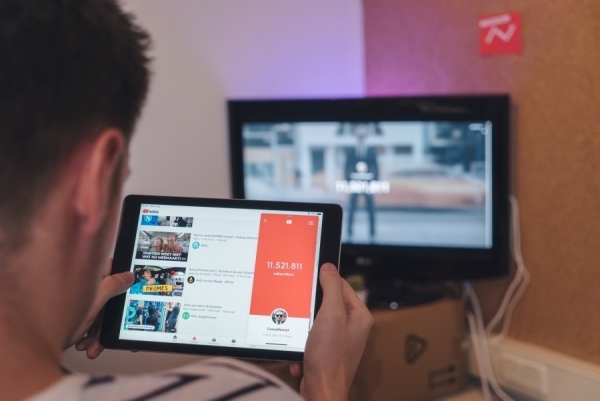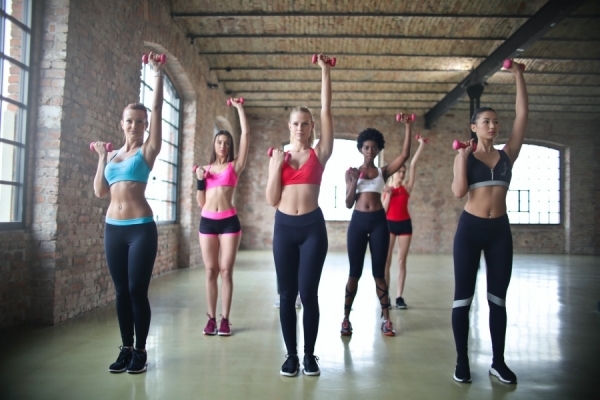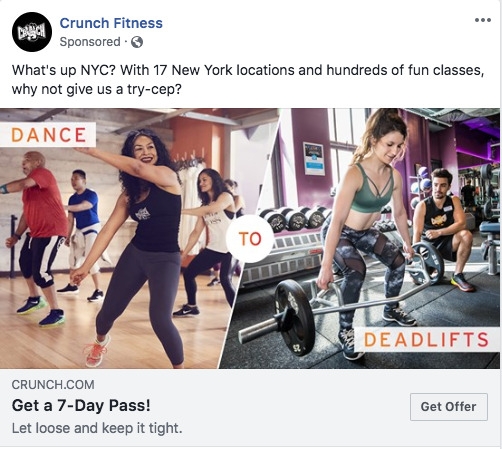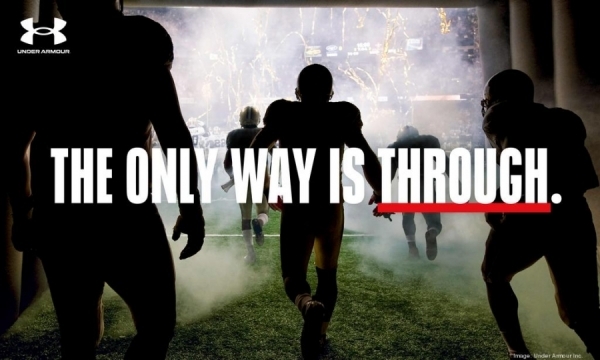

The examples you’re about to see come from various sectors: clothing, fitech, gym equipment and other fitness centres. Whatever these advertisements may be for, there’s something that you can take away from them as you consider your gym or fitness centre’s next advertising campaign.
Your next health and fitness advertisements
Aesthetics, emotion, marketing positioning, message and humour all play a massive part in any advertising campaign. Fitness centres need to find a delicate balance between these elements while also putting their branding and tone of voice into the equation.
Add another layer of complexity by considering the best channel to advertise to your target audience. Here are some channels to take your message to the masses:
Influencers
It’s hard to look past marketing in the fitness industry and not talk about influencers and social media. That’s because businesses on average pull in $5.20 for every $1 they put into influencer marketing and 89% of brands say it’s comparable to any other marketing channel.

The entire concept of working out and being fit is such an individual and personal process that we often look to other individuals for motivation and inspiration. Those who share their journeys become some inspirational, aspiration and influential - an influencer.
Take a look at our deep dive on growing your fitness club on Instagram.
Paid social media health and fitness advertisements
Influencers help you organically reach new audiences on social media, whereas paid social media lets you laser-focus on who you’re advertising to. Again, it's a complex world, but paying to present the right content to the right people can help you get more sign-ups, more faces at open days or more people to your site. The average CTR for social media ads in Q2 2020 was 1.3%, slightly up from 1.2% in 2019.
Use paid social media campaigns to promote the following content as part of your broader campaign:
Relatable vs motivational content
Creating graphics and other visual content to motivate people to dig deeper, push harder and go farther is a specific edge that your fitness ads campaign can take. However, you may very well intimidate and ward off potential customers who just want to feel healthier.
It’s hard to strike the right balance, but by doing so, you'll create an inclusive marketing campaign that brings in people from both ends of the spectrum.
Below you can see an example from Virgin Active Australia - a photo of someone pushing hard, but the post itself asks followers to tag their friends that make the funniest faces when they work out.

Consider creating content about the stories of regular attendees in your facility. Interview the powerlifter who's training for a competition and the mum who likes to get in her steps every second day before getting the kids from school.
With the current situation of some facilities having capped numbers or closed entirely, try to show social proof that any online classes or home workout sessions you've been working on that keep people fit during lockdown.
Events
Staying in the socially distanced theme, more and more people have turned to outdoor workouts thanks to the pandemic. In Germany, outdoor workouts increased by 29% in March 2020, compared to the previous month.

Many facilities have nurtured client engagement away from their facility by regularly holding small outdoor group training sessions. Such an event is awesome content for you to advertise to increase brand awareness, client engagement and reach new audiences.
Let’s look at some real-life health and fitness advertisements that you can use for your facility.
Alphalete & Alphaland
Christian Guzman, founder of activewear brand Alphalete, has diversified his ventures and created Alphaland. What was Alphalete gym, a fitness facility, has now evolved into an entire complex comprising three gyms, Alphalete headquarters and much more.
Youtubers are going to the facility, recording their workout and sharing their experience with their followers.
This creates more 'hype' and makes the place an even more exclusive place to go and work out. In turn, they are creating an ever-growing cycle of demand to go to the facility.
This isn't just generic influencer marketing; it's influencer marketing targeted to the right audience. Guzman and the Alphaland team know who wants to come through their doors and train there. And they target them appropriately.
Main Takeaway: If you’re to leverage influencer marketing, know your audience well, know what resonates with them and be prepared to create an environment they want to be a part of. 84% of social media users prefer live video - so use that to your advantage
Peloton
Peloton used their actual users as the basis of their 'We all have our reasons' campaign. The company focuses on nine users and what motivates them to get on their bike and do what they do.
Peloton's product is about convenience - being able to work out at home at a time that suits you.
And since we're all time-poor (over 50% of Brits consider themselves to be so), this campaign that highlights other time-poor individuals helps us relate to their product. It makes the viewer think, 'I'm busy like that, too'. This emotion of inclusivity allows the viewer to take the next step towards committing to the product.
Main Takeaway: Inclusivity speeds up a person's decision-making process, and this a positive example of health and fitness advertisements.
Crunch Fitness
Crunch Fitness have their paid social media marketing down to a fine art. They regularly promote fitness-related content to people within the area of their facilities. The idea of this fitness ads may be a new boot camp, a 6-week challenge, or an exciting recipe. When users land on Crunch's Facebook homepage, they see a Call To Action to sign up for a free trial at their local gym.
Should users visit the Facebook page and not take the offer, they're retargeted with more enticing fitness ads at a later date.

This example of Crunch Fitness illustrates a content marketing funnel; a series of finely crafted content, delivered over a period of time with the end goal of taking a certain action.
Main Takeaway: Use geo-based marketing campaigns to engage users and retargeting campaigns for those who didn't take the desired action.
8Fit
8Fit is a nutrition app for customised meal plans and workouts. It appeals to just about everyone: travellers, healthy eaters, bodybuilders and those of us that are just generally time-poor.
The content that 8Fit shares resonates with everyone.
As a Fitech company, it knows that not everyone can commit to a strict health or eating regime, but that people instead come and go, ebb and flow.
By sharing content that's humorous at the fact we're not perfect, it appeals to, well, just about anyone. Getting followers to say 'Haha, that's me' helps build a rapport and an investment in your brand.
An advertising campaign that's based on those imperfections that we all have can be empowering. It's another way to leverage emotion and those that mightn't be at their very best right now.
Main Takeaway: Be relatable. Bring out the imperfections in people so that they can't use their flaws as a reason not to work out or create a healthier lifestyle.
Adidas
Professional Female Sport has only 4% of the following of the male equivalent. For International Women's Day, Adidas teamed up with Goals4Girls, a program dedicated to keeping women in football fit, healthy and in love with their sport. The program also helps bring more attention to women’s professional football.
Adidas supports women in sport because it wants more women to be fit, active and healthy. Be helping bring more eyes to female sports does precisely that. By offering clothing and apparel to the foundation, they simultaneously help members of the program whilst spreading their brand name amongst a new audience.
Your fitness centre can do the same by using fitness ads that offer free use of your facilities for specific groups you'd like to see succeed. Also fitness advertisements may have positive impact on your company reach.
Main Takeaway: Emotion is powerful in marketing. For the fitness industry, specifically, empowerment can be both inspirational and motivational.
Under Armor
You just read about Adidas - but it may surprise you that as far back as 2014, Under Armor overtook Adidas as the number 2 sportswear brand in the US.
Under Armour's marketing began by offering a solution to a problem.
CEO Kevin Plank hated how his shirts would stick to him when playing football. So he developed a wicking style shirt. As a former NFL player, he gave several initial shirts to former teammates who were still playing professionally. Not long after, 2 NFL teams ended up buying shirts for their entire playing group.

Plank 'sold' the products to the teams by focussing on the benefits for the players. If they were a little less sweaty, they'd perform a little bit better, thus resulting in more wins and more money.
It didn't take long for team managers to see the benefits. This initial sale created an incredible to build many health and fitness advertisements upon.
Your fitness centre can channel the same principle.
Some audiences may not resonate with imagery and the idea of sweating hard on a stairmaster or pumping iron and getting bigger. Some may find more in common with the results of those processes - running and keeping up with the kids, pushing back ageing, or being more competitive in their amateur sport.
Main Takeaway: Show the benefits of living a healthy life rather than the 'struggle' of obtaining a healthy life.
Over to you
Effective health and fitness adverts are about nailing your messaging and branding to the right channels to the right people.
Use the above fitness ads examples as motivation, and create something that can make a real dent in your business's bottom line.